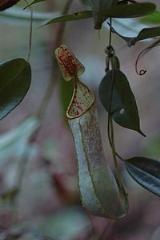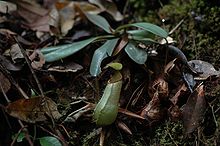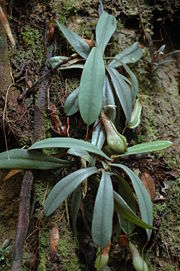
Nepenthes hispida
Encyclopedia
Nepenthes hispida is a tropical pitcher plant
species native to Borneo
. It grows at elevations of 100 to 800 m in kerangas forest
. It is known with certainty only from Lambir Hills National Park
and surrounding areas.
Nepenthes hispida is listed as Conservation Dependent
on the 2006 IUCN Red List of Threatened Species
.
In the wild, N. hispida is only known to hybridise with N. reinwardtiana
.
of N. hispida grows to 6 m in length and 6 mm in diameter. The cylindrical internode
s are up to 15 cm long. Leaves are sessile and coriaceous in texture. The lamina is oblanceolate-oblong in morphology and can measure up to 28 cm long and 4 cm wide. The apex of the lamina is acuminate-obtuse and often unequal. The base of the lamina is attenuate, amplexicaul, and often decurrent. Three longitudinal veins run along the lamina on each side of the midrib. Pennate veins are indistinct. Tendril
s grow to 15 cm in length.
 The pitchers of N. hispida are rarely more than 15 cm high and 8 cm wide. They are ovoid-ellipsoid in the lower parts and sub-cylindrical in the upper parts. Aerial or upper pitchers are more cylindrical than lower or terrestrial pitchers. Two fringed wings, up to 3 mm wide, run down the front of the pitchers. These wings are often absent in upper pitchers. The opening or mouth of the pitcher is ovate and oblique. The peristome
The pitchers of N. hispida are rarely more than 15 cm high and 8 cm wide. They are ovoid-ellipsoid in the lower parts and sub-cylindrical in the upper parts. Aerial or upper pitchers are more cylindrical than lower or terrestrial pitchers. Two fringed wings, up to 3 mm wide, run down the front of the pitchers. These wings are often absent in upper pitchers. The opening or mouth of the pitcher is ovate and oblique. The peristome
is rounded and up to 12 mm wide. The lid or operculum
is ovate-elliptic. An unbranched spur, up to 5 mm long, is inserted at the base of the lid.
Nepenthes hispida has a racemose
inflorescence
. The peduncle
is up to 5 cm long and 1.5 cm thick. The rachis
is attenuate and may grow to 10 cm in length. The partial peduncles, which are up to 8 mm long, are two-flowered at the base only, otherwise one-flowered. Sepal
s are elliptic and up to 4 mm long. Male and female inflorescences are of similar structure.
A very dense indumentum
of bristle-like, purple-grey hairs covers the stem. A sparser covering of shorter hairs is present on the inflorescence. Hairs on the surfaces of the leaves are apparently caducous, or shed at an early stage of development.
, Charles Clarke
writes: "N. hispida has been collected from a number of localities in northern Sarawak
and Brunei
, where its distribution overlaps with that of N. hirsuta". However, in Pitcher Plants of Sarawak, Clarke and Ch'ien Lee
state: "Recent observations of populations of N. hirsuta throughout Sarawak suggest that morphological variation in this species is much greater than previously assumed. Accordingly, the only plants that we equate with N. hispida here are those from the Lambir Hills area".
Nepenthes hispida grows in shady kerangas forest
on steep sandstone
ridges and is often sympatric with Eugeissona
palms. The species occurs at elevations of 100 to 800 m.
 Nepenthes hispida is very similar to the closely related N. hirsuta
Nepenthes hispida is very similar to the closely related N. hirsuta
and some taxonomists contest its status as a separate species. It is also similar to N. macrovulagris
, from which it differs in several aspects of pitcher and leaf morphology.
In his 1928 monograph, "The Nepenthaceae of the Netherlands Indies
", B. H. Danser
reduced N. hispida to a synonym of N. hirsuta, writing "N. hispida Beck is placed among the synonyms [of N. hirsuta] on the authority of Macfarlane
, though the description gives another idea". Matthew Jebb
and Martin Cheek
restored N. hispida to species status in 1997, citing the amplexicaul-decurrent leaf base and indumentum
as significant features that distinguish it from N. hirsuta. It has been suggested that N. hirsuta and N. hispida are extreme variants of the same species, as there exist intergrades between both taxa
.
Matthew Jebb and Martin Cheek suggest that N. hispida is related to N. philippinensis
, a species endemic to Palawan
in the Philippines
.
Pitcher plant
Pitcher plants are carnivorous plants whose prey-trapping mechanism features a deep cavity filled with liquid known as a pitfall trap. It has been widely assumed that the various sorts of pitfall trap evolved from rolled leaves, with selection pressure favouring more deeply cupped leaves over...
species native to Borneo
Borneo
Borneo is the third largest island in the world and is located north of Java Island, Indonesia, at the geographic centre of Maritime Southeast Asia....
. It grows at elevations of 100 to 800 m in kerangas forest
Kerangas forest
Sundaland heath forest, also known as Kerangas forest, is a type of tropical moist forest found on the island of Borneo, which is divided between Brunei, Indonesia, and Malaysia, as well as on the Indonesian islands of Belitung and Bangka, which lie to the west of Borneo.-Setting:The word Kerangas,...
. It is known with certainty only from Lambir Hills National Park
Lambir Hills National Park
Lambir Hills National Park is situated near Miri in Sarawak, Malaysia, on the island of Borneo. It is a small park, composed largely of mixed dipterocarp forest. A census of all trees in a 52 hectare plot found 1175 different species...
and surrounding areas.
Nepenthes hispida is listed as Conservation Dependent
Conservation Dependent
Conservation Dependent was an IUCN category assigned to species or lower taxa which were dependent on conservation efforts to prevent the taxon becoming threatened with extinction...
on the 2006 IUCN Red List of Threatened Species
IUCN Red List
The IUCN Red List of Threatened Species , founded in 1963, is the world's most comprehensive inventory of the global conservation status of biological species. The International Union for Conservation of Nature is the world's main authority on the conservation status of species...
.
In the wild, N. hispida is only known to hybridise with N. reinwardtiana
Nepenthes reinwardtiana
Nepenthes reinwardtiana , Reinwardt's Pitcher-Plant, is a Nepenthes species found on the islands of Borneo and Sumatra. Although some sources have included Peninsular Malaysia and Singapore within the range of this species, these records appear to be erroneous.Nepenthes reinwardtiana has an...
.
Description
The stemPlant stem
A stem is one of two main structural axes of a vascular plant. The stem is normally divided into nodes and internodes, the nodes hold buds which grow into one or more leaves, inflorescence , conifer cones, roots, other stems etc. The internodes distance one node from another...
of N. hispida grows to 6 m in length and 6 mm in diameter. The cylindrical internode
Plant stem
A stem is one of two main structural axes of a vascular plant. The stem is normally divided into nodes and internodes, the nodes hold buds which grow into one or more leaves, inflorescence , conifer cones, roots, other stems etc. The internodes distance one node from another...
s are up to 15 cm long. Leaves are sessile and coriaceous in texture. The lamina is oblanceolate-oblong in morphology and can measure up to 28 cm long and 4 cm wide. The apex of the lamina is acuminate-obtuse and often unequal. The base of the lamina is attenuate, amplexicaul, and often decurrent. Three longitudinal veins run along the lamina on each side of the midrib. Pennate veins are indistinct. Tendril
Tendril
In botany, a tendril is a specialized stem, leaf or petiole with a threadlike shape that is used by climbing plants for support, attachment and cellular invasion by parasitic plants, generally by twining around suitable hosts. They do not have a lamina or blade, but they can photosynthesize...
s grow to 15 cm in length.

Peristome
The word peristome is derived from the Greek peri, meaning 'around' or 'about', and stoma, 'mouth'. It is a term used to describe various anatomical features that surround an opening to an organ or structure. The term is used in plants and invertebrate animals, such as in describing the shells of...
is rounded and up to 12 mm wide. The lid or operculum
Operculum (botany)
An operculum, in botany, is a term generally used to describe a structure within a plant, moss, or fungus acting as a cap, flap, or lid. In plants, it may also be called a bud cap.Examples of structures identified as opercula include:...
is ovate-elliptic. An unbranched spur, up to 5 mm long, is inserted at the base of the lid.
Nepenthes hispida has a racemose
Raceme
A raceme is a type of inflorescence that is unbranched and indeterminate and bears pedicellate flowers — flowers having short floral stalks called pedicels — along the axis. In botany, axis means a shoot, in this case one bearing the flowers. In a raceme, the oldest flowers are borne...
inflorescence
Inflorescence
An inflorescence is a group or cluster of flowers arranged on a stem that is composed of a main branch or a complicated arrangement of branches. Strictly, it is the part of the shoot of seed plants where flowers are formed and which is accordingly modified...
. The peduncle
Peduncle (botany)
In botany, a peduncle is a stem supporting an inflorescence, or after fecundation, an infructescence.The peduncle is a stem, usually green and without leaves, though sometimes colored or supporting small leaves...
is up to 5 cm long and 1.5 cm thick. The rachis
Rachis
Rachis is a biological term for a main axis or "shaft".-In zoology:In vertebrates a rachis can refer to the series of articulated vertebrae, which encase the spinal cord. In this case the rachis usually form the supporting axis of the body and is then called the spine or vertebral column...
is attenuate and may grow to 10 cm in length. The partial peduncles, which are up to 8 mm long, are two-flowered at the base only, otherwise one-flowered. Sepal
Sepal
A sepal is a part of the flower of angiosperms . Collectively the sepals form the calyx, which is the outermost whorl of parts that form a flower. Usually green, sepals have the typical function of protecting the petals when the flower is in bud...
s are elliptic and up to 4 mm long. Male and female inflorescences are of similar structure.
A very dense indumentum
Indumentum
The indumentum is a covering of fine hairs or bristles on a plant or insect.In plants, the indumentum types are:*pubescent*hirsute*pilose*villous*tomentose*stellate*scabrous*scurfy...
of bristle-like, purple-grey hairs covers the stem. A sparser covering of shorter hairs is present on the inflorescence. Hairs on the surfaces of the leaves are apparently caducous, or shed at an early stage of development.
Distribution and habitat
In Nepenthes of BorneoNepenthes of Borneo
Nepenthes of Borneo is a monograph by Charles Clarke on the tropical pitcher plants of Borneo. It was first published in 1997 by Natural History Publications , and reprinted in 2006. Clarke describes it as "primarily an ecological monograph"...
, Charles Clarke
Charles Clarke (botanist)
Dr. Charles M. Clarke is a botanist and taxonomist specialising in the carnivorous plant genus Nepenthes. Clarke has an honours degree in Botany from Monash University in Melbourne, and a Ph.D. in Ecosystem Management at the University of New England, in Armidale, New South Wales.Clarke first...
writes: "N. hispida has been collected from a number of localities in northern Sarawak
Sarawak
Sarawak is one of two Malaysian states on the island of Borneo. Known as Bumi Kenyalang , Sarawak is situated on the north-west of the island. It is the largest state in Malaysia followed by Sabah, the second largest state located to the North- East.The administrative capital is Kuching, which...
and Brunei
Brunei
Brunei , officially the State of Brunei Darussalam or the Nation of Brunei, the Abode of Peace , is a sovereign state located on the north coast of the island of Borneo, in Southeast Asia...
, where its distribution overlaps with that of N. hirsuta". However, in Pitcher Plants of Sarawak, Clarke and Ch'ien Lee
Ch'ien Lee
Ch'ien C. Lee is a photographer and botanist specialising in the carnivorous plant genus Nepenthes. Lee has described several new Nepenthes species, including N. chaniana, N. gantungensis, N. glandulifera, N. jamban, N. lingulata, N. palawanensis, N. pitopangii,...
state: "Recent observations of populations of N. hirsuta throughout Sarawak suggest that morphological variation in this species is much greater than previously assumed. Accordingly, the only plants that we equate with N. hispida here are those from the Lambir Hills area".
Nepenthes hispida grows in shady kerangas forest
Kerangas forest
Sundaland heath forest, also known as Kerangas forest, is a type of tropical moist forest found on the island of Borneo, which is divided between Brunei, Indonesia, and Malaysia, as well as on the Indonesian islands of Belitung and Bangka, which lie to the west of Borneo.-Setting:The word Kerangas,...
on steep sandstone
Sandstone
Sandstone is a sedimentary rock composed mainly of sand-sized minerals or rock grains.Most sandstone is composed of quartz and/or feldspar because these are the most common minerals in the Earth's crust. Like sand, sandstone may be any colour, but the most common colours are tan, brown, yellow,...
ridges and is often sympatric with Eugeissona
Eugeissona
Eugeissona is a clustering genus of flowering plant in the palm family native to Borneo, Thailand and Malaysia. The six monoecious species provide a wide range of local uses and are commonly called bertam or wild Bornean sago...
palms. The species occurs at elevations of 100 to 800 m.
Taxonomy

Nepenthes hirsuta
Nepenthes hirsuta , the Hairy Pitcher-Plant, is a tropical pitcher plant endemic to Borneo. It is characterised by an indumentum of thick brown hairs, which is even present on the inflorescence. Pitchers are mostly green throughout with some having red blotches on the inside surfaces.N. hirsuta...
and some taxonomists contest its status as a separate species. It is also similar to N. macrovulagris
Nepenthes macrovulgaris
Nepenthes macrovulgaris , or the Serpentine Pitcher-Plant, is a tropical pitcher plant endemic to Borneo. It is a lowland plant that typically grows at altitudes ranging from 300 to 1200 m in sub-montane forest clearings and mossy forest...
, from which it differs in several aspects of pitcher and leaf morphology.
In his 1928 monograph, "The Nepenthaceae of the Netherlands Indies
The Nepenthaceae of the Netherlands Indies
"The Nepenthaceae of the Netherlands Indies" is a seminal monograph by B. H. Danser on the tropical pitcher plants of the Dutch East Indies, North Borneo, the Malay Peninsula, and eastern New Guinea...
", B. H. Danser
B. H. Danser
Benedictus Hubertus Danser , often abbreviated B. H. Danser, was a Dutch taxonomist and botanist...
reduced N. hispida to a synonym of N. hirsuta, writing "N. hispida Beck is placed among the synonyms [of N. hirsuta] on the authority of Macfarlane
John Muirhead Macfarlane
John Muirhead Macfarlane was a Scottish botanist. He was born and educated in Scotland, where he occupied several different academic positions at the University of Edinburgh before emigrating to the United States to assume a professorial chair at the University of Pennsylvania in 1893. He held...
, though the description gives another idea". Matthew Jebb
Matthew Jebb
Dr. Matthew H. P. Jebb is an Irish taxonomist and botanist specialising in the ant plant genera Squamellaria, Myrmecodia, Hydnophytum, Myrmephytum and Anthorrhiza, as well as the carnivorous plant genus Nepenthes....
and Martin Cheek
Martin Cheek
Dr. Martin Roy Cheek is a taxonomist and botanist specialising in the carnivorous plant genus Nepenthes.-Research:Cheek has described several new Nepenthes species, mostly with Matthew Jebb, including: N. argentii, N. aristolochioides, N. danseri, N. diatas,...
restored N. hispida to species status in 1997, citing the amplexicaul-decurrent leaf base and indumentum
Indumentum
The indumentum is a covering of fine hairs or bristles on a plant or insect.In plants, the indumentum types are:*pubescent*hirsute*pilose*villous*tomentose*stellate*scabrous*scurfy...
as significant features that distinguish it from N. hirsuta. It has been suggested that N. hirsuta and N. hispida are extreme variants of the same species, as there exist intergrades between both taxa
Taxon
|thumb|270px|[[African elephants]] form a widely-accepted taxon, the [[genus]] LoxodontaA taxon is a group of organisms, which a taxonomist adjudges to be a unit. Usually a taxon is given a name and a rank, although neither is a requirement...
.
Matthew Jebb and Martin Cheek suggest that N. hispida is related to N. philippinensis
Nepenthes philippinensis
Nepenthes philippinensis is a tropical pitcher plant endemic to the Philippines. It is known from Palawan and the Calamian Islands , where it grows at 0–600 m above sea level....
, a species endemic to Palawan
Palawan
Palawan is an island province of the Philippines located in the MIMAROPA region or Region 4. Its capital is Puerto Princesa City, and it is the largest province in the country in terms of total area of jurisdiction. The islands of Palawan stretch from Mindoro in the northeast to Borneo in the...
in the Philippines
Philippines
The Philippines , officially known as the Republic of the Philippines , is a country in Southeast Asia in the western Pacific Ocean. To its north across the Luzon Strait lies Taiwan. West across the South China Sea sits Vietnam...
.

